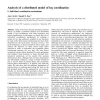Free Online Productivity Tools
i2Speak
i2Symbol
i2OCR
iTex2Img
iWeb2Print
iWeb2Shot
i2Type
iPdf2Split
iPdf2Merge
i2Bopomofo
i2Arabic
i2Style
i2Image
i2PDF
iLatex2Rtf
Sci2ools
BC
2000
2000
Analysis of a distributed model of leg coordination
Using tools from discrete dynamical systems theory, we begin a systematic analysis of a distributed model of leg coordination with both biological and robotic applications. In this paper, we clarify the role of individual coordination mechanisms by studying a system of two leg oscillators coupled in one direction by each of the three major mechanisms that have been described for the stick insect Carausius morosus. For each mechanism, we derive analytical return maps, and analyze the behavior of these return maps under iteration in order to determine the asymptotic phase relationship between the two legs. We also derive asymptotic relative phase densities for each mechanism and compare these densities to those obtained from numerical simulations of the model. Our analysis demonstrates that, although each of these mechanisms can individually compress a range of initial conditions into a narrow band of relative phase, this asymptotic relative phase relationship is, in general, only neutra...
| Added | 17 Dec 2010 |
| Updated | 17 Dec 2010 |
| Type | Journal |
| Year | 2000 |
| Where | BC |
| Authors | Alan Calvitti, Randall D. Beer |
Comments (0)

